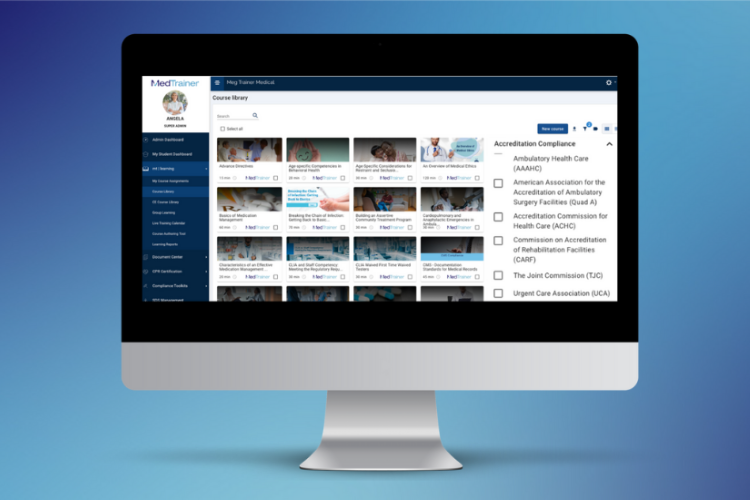More than 90% of employees say they won’t quit if they get development opportunities, and 92% think workplace training positively impacts their job engagement. These are some of the reasons why more healthcare organizations than ever before are providing CEU classes at no cost to employees.
Staffing is at a critical point — the average U.S. hospital had to replace 100.5% of its staff in the past five years. If offering free continuing education can save your organization the thousands of dollars it costs to replace one employee, it’s worth it, right?
If you’re still unconvinced, we’ve compiled five reasons healthcare organizations provide no-cost continuing education for licensed employees.
5 Reasons Employers Provide CEU Continuing Education
1. Ability to address skills gaps.
Providing continuing education to employees allows administrators to promote topics and skills relevant to the organization’s specific operations, patient population, or care setting. As leaders notice trends in incident reports, skills assessments, or patient feedback, they can offer targeted CEU courses to upskill their workforce in the critical areas identified. A workforce with standardized training on best practices will likely own better compliance-related and patient care-focused tasks, critical to quality-related metrics that top healthcare facilities are expected to excel in for a profitable reimbursement model.
2. Stay competitive.
Companies that invest in continuing education and professional development programs for their employees typically maintain a higher retention rate. In healthcare, that’s largely because CEUs are expensive. Most state licenses require continuing education for license renewal; professionals can spend thousands earning these credits. These cost savings year after year can help organizations retain their best employees.
Employees who feel like their organization is invested in their career and development are likelier to stay. This offers both the staff and the organization a path for career advancement. It keeps the employee satisfied and engaged and gives confidence that you have strong employees ready to step into roles with additional responsibilities.
3. It’s easy.
With many options available, it’s easier than ever for organizations to make CEs accessible with online options. Healthcare organizations already have to provide required compliance training — choosing a learning management system (LMS) that includes online continuing education unit classes is easy.
Online options limit the time off required for in-person learning opportunities and make it easier for busy healthcare professionals with unpredictable schedules. If your organization provides services in remote or rural areas, time and budget constraints can make it difficult for providers in small and medium-sized organizations to travel long distances to avail of quality CE opportunities. In these instances — online CE courses can be an equalizer — allowing rural providers to stay on top of best and current clinical practices and skills in their scope of practice.
Online training is often more affordable than traditional in-person courses because it does not require physical classroom space, instructors, or materials. This ease is why many healthcare organizations offer employees access to no-cost CE.
4. Facilitate the shift to value-based care.
Continuing education is critical as the healthcare industry shifts to value-based care (VBC), where doctors and other healthcare providers work together to improve outcomes. Providers are incentivized to prevent hospitalizations and illness.
Using an LMS, employers are well-positioned to offer CE that helps providers transition from fee-for-service — or volume-based — models that may impact organizational revenue. For example, if you rush a patient out the door, misdiagnose them, or discharge them without proper counseling — and they are readmitted within 30 days — the hospital may not be reimbursed for initial services.
VBC requires providers to look holistically at the causes of a person’s condition, collaborate with other professionals on an end-to-end treatment plan, and deliver care that keeps the patient from returning. As providers make this shift in thinking, they may have knowledge gaps that CE can help close. Employers can offer CE courses to bridge those gaps, empower staff to deliver better care, and contribute to the financial health of your organization.
5. Attract top talent.
As the administrative burden on providers has increased, providing them with ways to save time has become increasingly important. Providing access to a platform that can help them with this so they do not have to look for CEs and then try to obtain documentation to validate their CE hours for each activity they participated in takes something off their plate so they can focus on important activities such as patient care.
Professionals often struggle to figure out what types of CEs, topics, or duration-related requirements their particular licensing body has in their state. This can get particularly tricky if they are juggling multiple licenses or trying to meet their administrative obligations alongside this task.
Help your staff stay on top of their licensure maintenance obligations by providing no-cost access to a vetted platform to help manage their CEs. A platform with a real compliance and CE maintenance support team can help with this by providing well-researched, up-to-date bundles that meet the requirements for licensed professionals so they don’t have to.
How To Easily Provide CEUs To Employees
A robust learning management system (LMS) makes providing CEU continuing education for staff easy. Choose a healthcare-specific LMS that includes continuing education as part of the included course library. In addition to accessible online courses, a healthcare-specific LMS will automatically track completion and issue certificates stored in the employee’s profile. This makes it easy for the employee to access the information needed for license renewal.
MedTrainer Learning offers more than 300 continuing education courses approved by national organizations, including:
- American Nurses Credentialing Center (ANCC)
- American Dental Association (ADA CERP)
- American Association of Medical Assistants (AAMA)
- National Association of Social Workers (NASW)
- National Board of Certified Counselors (NBCC)

